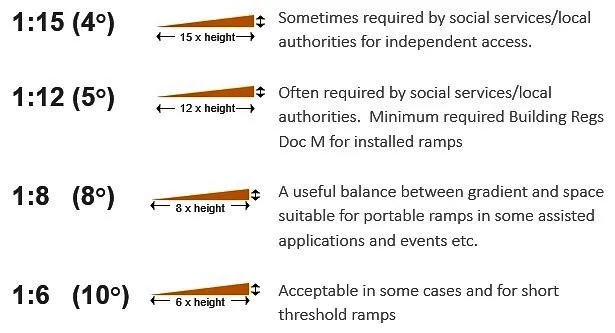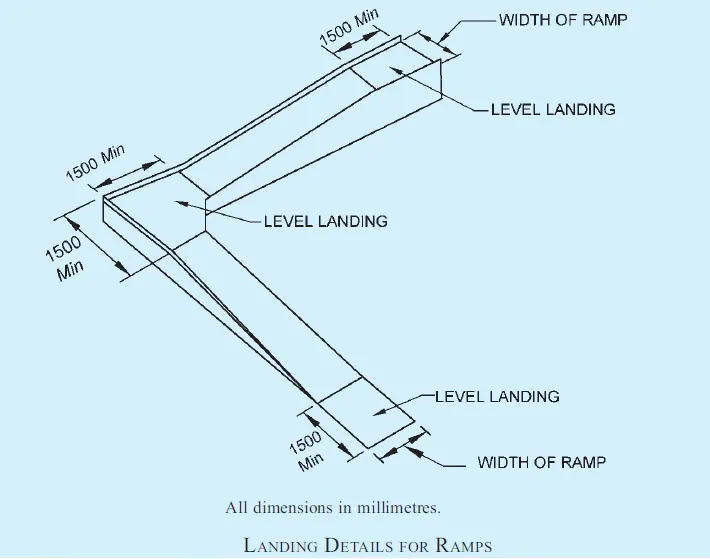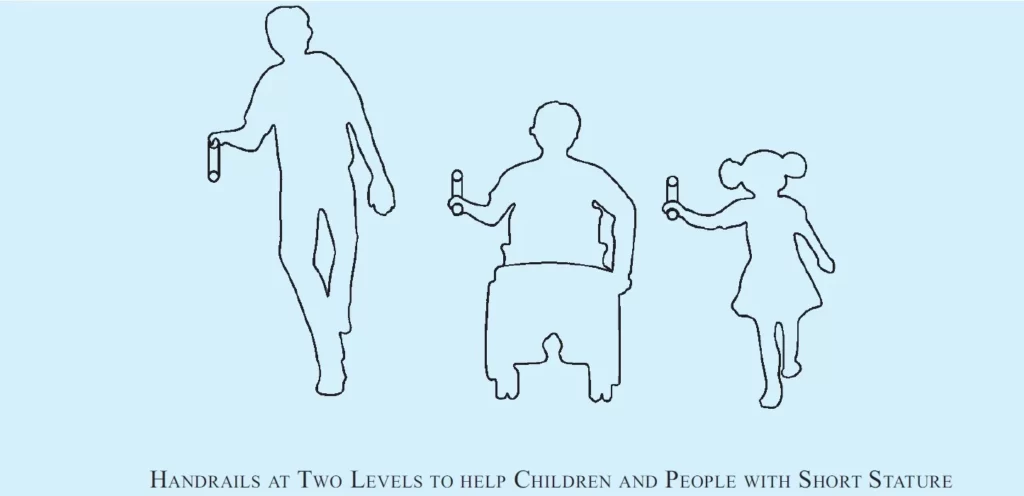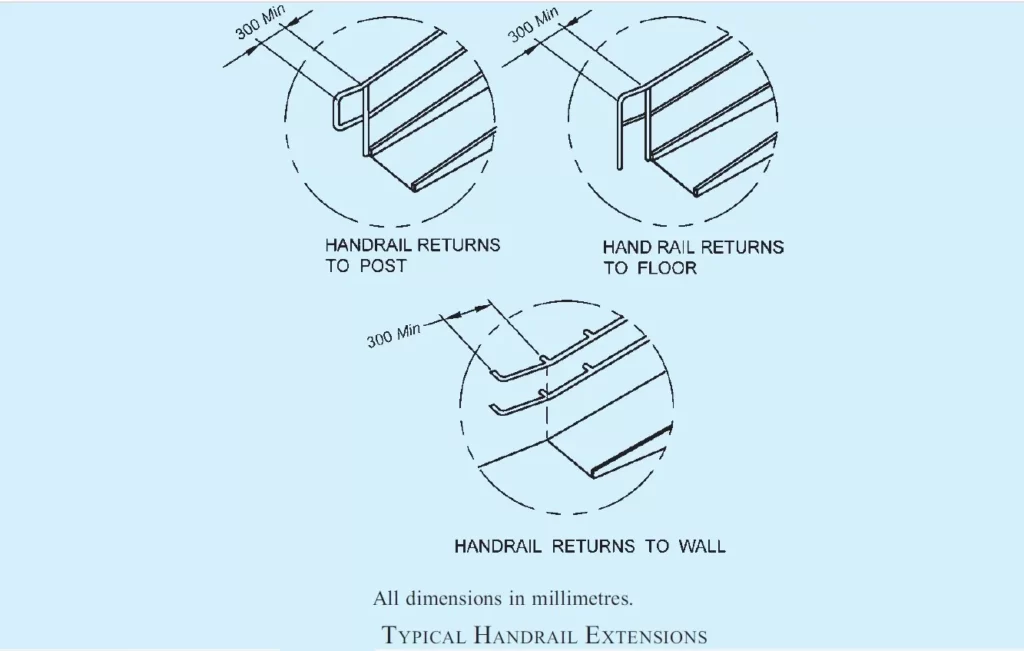If you want to know about the refuge area or toilet design or requirements for disabled persons in a building, please click the link.
A ramp is a sloping pathway leading from one level to another. Ramps of an appropriate design shall be provided at all changes in level other than those served by an accessible lift or accessible lifting mechanism accommodating the specific requirements of persons with disabilities.
Ramps allow persons with reduced mobility to move from one level to another. However, many ambulant persons with disabilities negotiate steps more easily and safely. Hence it is preferable to provide accessibility by both steps and ramps.

1) Ramps shall meet the following general requirements
- Wherever the rise of a ramp exceeds 300 mm, an additional flight of steps shall also be provided as described in staircase, shall be provided for ambulant persons. An isolated single step is not acceptable; hence, a ramp is preferred to a single step.
- Where there is a large change in elevation that requires multiple ramps and landing combination, other solutions such as lifts should be considered.
- Ramps should not ideally connect straight to doors as wheelchair users need a levelled platform at the end of the ramp to manoeuvre and negotiate opening the door.
- A curved ramp is not a preferred design solution. Similarly, a cross fall may put a wheelchair user at risk and may adversely affect steering, particularly on manually propelled chair.
- Shiny, polished surface materials that cause glare shall not be used for ramps.
- Single row of tactile warning blocks (TGSI) shall be placed (as per shown in figure below) at the beginning and end of each ramp. This shall be placed 300 mm before the beginning and end of each ramp run to indicate the level change to visually impaired persons.

i) Gradient
The gradient shall be constant between landings. The minimum specifications for ramp gradients addressing different level differences are given in Table (see also figure below).


ii) Width
The minimum clear width of a ramp (exclusive of handrails) shall be 1200 mm and shall increase correspondingly as the level difference addressed by the ramp increases as per Table above.
iii) Surface
- Ramps and landing surfaces shall be non-glary, smooth, level, even and slip resistant even when wet. Outdoor ramps and their surface shall be designed to prevent water from accumulating on the walking surfaces. The surface finish shall be hard and suitable for the volume of traffic that the ramp is likely to experience.
- Internal ramps should, if possible, be avoided. Where required, internal ramps shall be designed in accordance with the following additional criteria:
- No series of ramps should rise more than 2000 mm in total. If this is the case, an alternative should be provided, for example a lift.
- An internal ramp should have the lowest practical gradient. In order to avoid trips and falls during a fire evacuation, a gradient of 1:15 should be the maximum permissible gradient within a building.
- The minimum illumination at the top and bottom of the ramp should be 200 lux and 150 lux in between the bottom and top.
iv) Landings
- An end landing shall be provided at the bottom and the top of a sloped path, a stepped path, or a ramp and also where the run changes direction.
- The area of the end landing may be a part of the continuing path (see Figure below).

- The length of an end landing and an intermediate landing shall be not less than 1500 mm. Where the ramp run changes direction, the minimum landing dimensions shall be 1500 mm × 1500 mm.
- The area of a landing shall be clear of any obstruction including the path of swing of a door or a gate. Landings shall also be provided at regular intervals of not more than 9000 mm of every horizontal run. It shall conform to other provisions of this annex if served by a doorway. If the end landing follows or precedes a turn for a pathway or an entrance, the minimum dimension of the landing shall be minimum 1500 mm × 1500 mm.
- The width of ramp and consequently the dimension of landing in the direction perpendicular to the direction of ramp shall also be governed by the provisions of Table below.

v) Handrails for Ramps
A ramp run with a vertical rise greater than 150 mm shall have handrails that are on both the sides and comply with…..
- They shall be provided on both the sides.
- They shall be continuous, even at the landings.
- They shall extend at least 300 mm beyond the first and last nosing. A handrail shall not project into a transverse circulation path unless it is continuous and intended to form part of the guidance along that path. The end of the horizontal extension should be turned towards the wall on the closed side of the ramp or stairs, or be turned down and terminate at the floor or ground level.
- They shall have a minimum clear space of 50 mm from the walls; and
- The height to the top of a handrail shall be between 850 mm and 950 mm above the surface of a ramp, the pitch line of a stair, and the surface of a landing. A second handrail, with a lower profile than the first one, shall be provided. The height to the top of the second handrail should be between 650 mm and 750 mm above the surface of a ramp, the pitch line of a stair, and the surface of a landing. There shall be sufficient distance between the two handrails (say, 200 mm).
- In case the handrail is enclosed in a recess, the recess shall extend at least 450 mm above the top of the rail.


These guidelines ensure that ramp design in architecture provides safe and accessible access to buildings while adhering to the NBC of India’s standards.